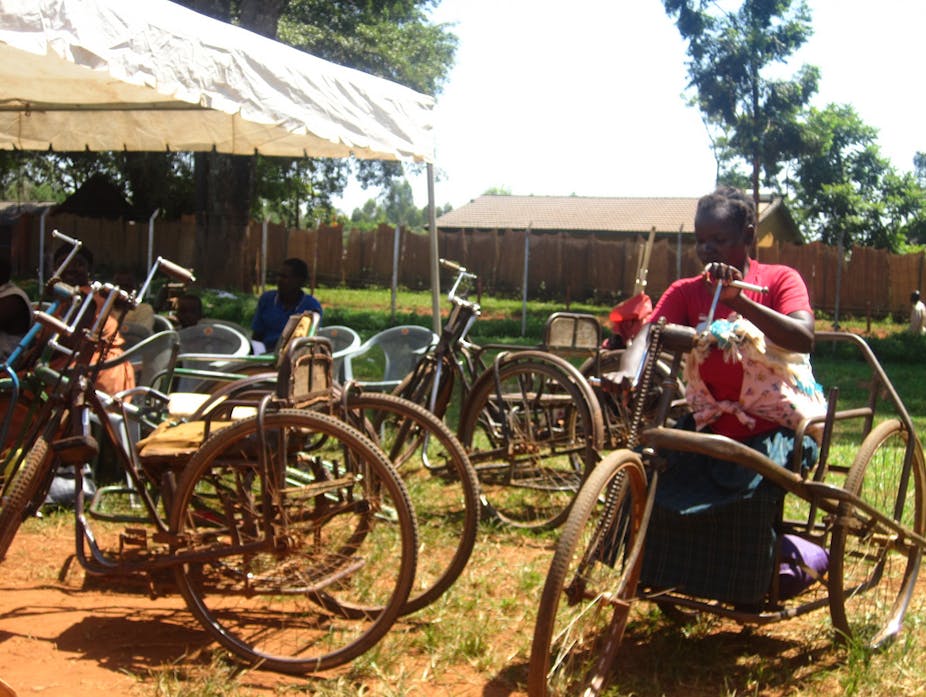Disabled people are severely marginalised and among the poorest in developing countries. Having a disability increases the risk of poverty, and being poor also increases the risk of getting a disability. This can come from poor living conditions, lack of access to safe water and preventative health treatments such as immunisations and vaccinations, as well as injury through employment or conflict.
The World Health Survey estimates that about 15.6% of the global population suffers from a disability. This equates to around 785m adults; of which 80m (10%) live in Africa. And despite aims to eradicate polio, a significant number - between 10m to 20m - are polio survivors.
Health-care services in developing countries are often highly constrained, further excluding the poor and increasing the likelihood that a health condition could result in impairment. And research in this area remains limited, in part because of cultural taboos, a lack of data and the sad reality that disability is not a priority expenditure area for many countries. Discussion and funding in countries that provide aid centres on eradicating diseases such as polio rather than tackling issues that arise from them, which includes disability.
But there are also clear economic reasons for tackling stigma and enabling people living with a disability to participate in the African economy.
The economics of education
In addition to a lower standard of living and its adverse impact on education, employment, income and increased expenditures on disability-related services, there are also indirect costs for carers who support disabled family members. The effects on education can be felt at all stages of a person’s life, beginning from the disabled child being prevented from attending school by their parents due to social stigma and embarrassment, to a lack of economic incentive and alternative employment in household duties or businesses.
Alternatively, where children are “allowed” to attend school it maybe inaccessible – due to distance, lack of adapted facilities, and the effect of negative attitudes encountered along the way. These factors all work to limit human capital accumulation, which affects future employment and its returns. Disability also determines the nature of the job, as well as the associated workload - in agrarian economies, characterised by physical, manual labour, disabled people are at a particular disadvantage.
A Ugandan example
In Uganda, various estimates suggest there are between 2.4 and 5m disabled people, most of whom are poor (or live in poor households) and nearly half suffer from a physical disability.
Although the Ugandan government is considered to be among the world leaders when it comes to political empowerment of disabled people (more than 47,000 disabled elected representatives at various levels of national and community government), there are few actual government programmes to assist them.
In June 2012 and 2013 a group of Nottingham University economists, medics and orthotists conducted a randomised control trial in Uganda to evaluate the impact of orthotics - callipers, crutches, shoes and other mobility aids - on disabled peoples’ life chances.
The aim was to quantify the economic benefits, as well as changes in quality of life, mobility and self-reported satisfaction of treating people with physical impairments, the majority of which (78%) were caused by polio.
The data isn’t yet published but preliminary analysis shows that as expected, life is indeed significantly poorer for the sample of disabled adults than the national population. It also shows that if people know about institutions to support them, it can make a difference. In particular women in contact with these kinds of institutions received higher earnings than those who weren’t.
Providing orthotic treatment improved the welfare of disabled people - increased mobility resulted in increased economic participation and earnings - and participants reported improved quality of life.
This is just one way of improving lives. But in developing countries, disabled people are neglected by public health authorities, donors and NGOs and yet with appropriate treatment, they have the potential to be economically active. Improving life is an important aim, but there’s also an economic argument for directing more funds to this marginalised group.

